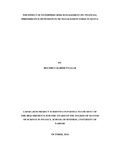| dc.description.abstract | There are currently over 1,200 pension schemes in Kenya managed by 19 pension fund management firms registered with Retirement Benefits Authority. These firms usually receive pension fund contributions from their corporate and individual clients and invest these funds on their behalf as pooled or segregated funds as agreed. The firms declare different interest rates annually from their investment returns and this attracts more pension schemes to the funds that can offer greater returns. Further, the RBA Act specifies how investment risk can be managed by placing caps on the maximum that can be invested in various portfolios. Therefore, how well a pension fund management firm is able to manage the risks may be an important ingredient to better financial performance. This is the challenge to the pension fund management firms in Kenya. The study sought to determine the level of implementation of enterprise risk management by pension fund management firms in Kenya and to assess the effect of enterprise risk management on the firm’s financial performance. This study adopted a descriptive study design. The population for this study was the 19 registered pension fund management firms in Kenya by July 2014 from which 11 agreed to take part in the survey giving a response rate of 58%. Both primary and secondary data were used. Primary data was collected using questionnaires structured based on the objectives of the study. This specifically collected data on the practice and implementation of enterprise risk management by fund managers. The research instrument was administered through mail and drop and pick later methods. The respondents were the risk and compliance managers in each of the selected f. Secondary data was collected for purposes of identifying performance indices and other control variable such as size of the firms, growth, and leverage from the financial statements of each of these pension fund management firms. Data was analysed using both descriptive and linear regression analysis. The regression results revealed that the model accounted for 99.3% of the variance in financial performance as shown by the R2 value. The F-statistic of 38.3 was significant at 5% level, suggesting that the model was fit to explain the relationship between enterprise risk management and financial performance. The coefficient results showed that event identification, risk assessment, objective setting, and information communication had negative effects on the financial performance of fund management firms while risk response, internal environment, and control activities had positive effects on the financial performance of pension fund management firms in Kenya. However, the effects of even identification and risk response on financial performance were insignificant at 5% level. Thus, the study concludes that enterprise risk management practices influence the financial performance of pension fund management firms in Kenya to a very large extent. The study recommends that the pension fund management firms in Kenya should employ robust enterprise risk management practices, improve on internal environment assessment procedures and control activities as these are likely to influence their financial performance in one way or another. Retirement Benefits Authority should regularly evaluate ERM practices of pension fund management firms and reward those with excellent practices. | en_US |

